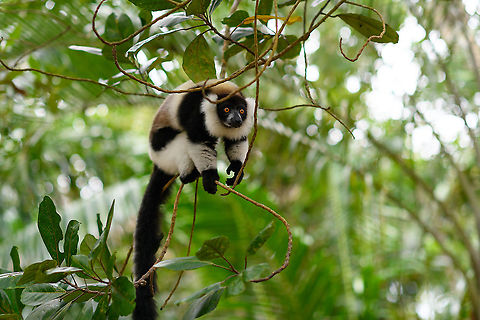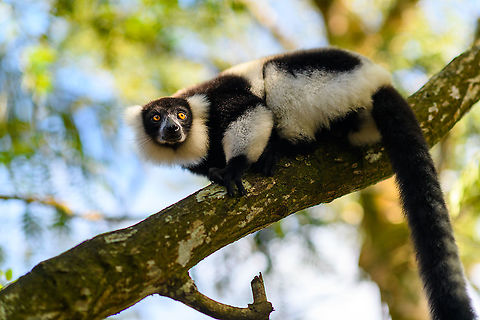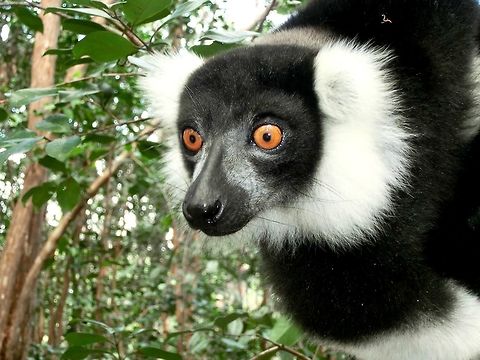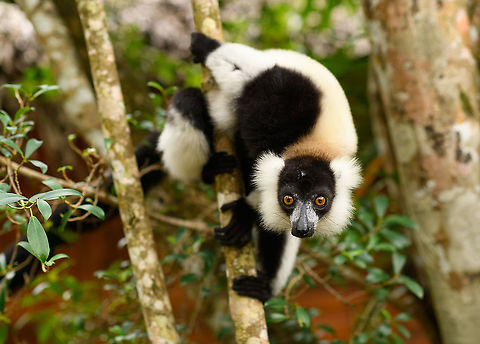
Appearance
The black and white lemur is always both black and white, their general color patterns do not usually vary. The black-and-white ruffed lemur abdomen, tail, hands and feet, inner limbs, forehead, face and crown are black. Pelage is white on the sides, back, hind limbs and on the hindquarters. Males and females look the same.Gron KJ. 2007 August 17. Primate Factsheets: Ruffed lemur Taxonomy, Morphology, & Ecology.
Distribution
The Varecia Variegatta ‘s population is on a downward trend. The general population is decreasing dramatically. Studies have shown overtime that in the last 27 years there has been an 80% decrease in individual black and white ruffed lemurs. From the Vasey studies of 2003 it was shown that the most densely populated area of black and white ruffed lemurs was Nosy Mangabe. It had around 29-43 individuals/km2. Consequently came Anatanamatazo with 10-15 individuals/km2, and then Manomba with.4-2.5 individuals/km2.
Behavior
The black-and-white ruffed lemur demonstrates several different call types each of which last several seconds. Most lemurs of a group participate in any one chorus. These lemurs are particularly known for their loud roar/shriek choruses which have several purposes including group movement, spacing among different groups, and alarming other members of the group of predators. Unlike the calls of other species, the calls of the black-and-white ruffed lemur are not likely to be for the establishment of territory for a group. The calling behavior is participated in throughout the course of a day, not concentrated at any one point of the day; however calls are usually not heard at night.Studies of groups of black-and-white ruffed lemurs both in captivity and in the wild have demonstrated a variety of social structures from pairs to large groups. Parenting in this species of lemurs is unique in that no single infant is invested in but instead, females bare litters of multiple offspring. Males also play a role in the parenting of the offspring especially in smaller groups where the certainty of paternity is high. In larger groups, the chance of a female mating with more than one male increases as does uncertainty in paternity. This tends to decrease the level of male care of offspring. Instead of clinging to the mother, offspring are placed into a nest which is guarded by both parents.
Habitat
Ruffed lemurs are the most frugivorous of all the lemur species, they will and often do feed on over 80 to 132 different plant species. Studies show that most of their feeding time is spent on basic fruit which consumes around 80% of that time. The rest of which is spent mostly on nectar and various other forage. In general most male black and white ruffed lemurs will eat less than a female will during the hot dry seasons of Madagascar. Another difference between the diet of male and female ruffed lemurs is that when a female is pregnant and also lactating she will eat significantly more flowers and leaves than the male in order to supply her child and the high energy cost of reproduction. Of the general plants they eat, the most common types are Canarium , Cryptocarya, Ocotea, Ravensara , Ficus , Eugenia/Syzygium , and Grewia . Studies recording ruffed lemurs in captivity and in the wild over the course of a year show that ruffed lemurs on an average spend around 28% of their time feeding, 53% resting, and the last 19% socializing and moving about.
Predators
While predators may be a large threat to the black and white ruffed lemur, the principal threat to their survival comes from the inhabitants of the island. Since they are comparatively large to other species of lemurs they are hunted for their meat by poachers and village men who are looking to feed their families. Another threat to the lemurs is the agricultural practices of the local community. The slash and burn method of agriculture is very devastating to the natural habitat of the black and white ruffed lemur.The black-and-white ruffed lemur is preyed upon by the Henst's goshawk , fossa , ring-tailed mongoose and brown-tailed mongoose . Nesting behavior poses the greatest risks for predation, especially mammalian predators.
References:
Some text fragments are auto parsed from Wikipedia.